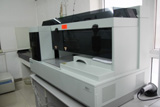How Can We Infer the Type of Nephropathy Before Renal Biopsy
2018-04-24 11:25It is very important to deduce pathological types from laboratory tests for the treatment of nephropathy in the patients who are not suitable for renal biopsy or have poor compliance.
The kidney consists of two parts: glomeruli and tubulointerstitium. Glomerulus is the mainly nidus for nephropathy patients. And glomerular diseases have two distinct characteristics: albuminuria and hematuria.
Hematuria presents for different forms of red blood cells in urine. Once the kidneys are damaged, and red blood cells are squeezed and deformed in the process of leakage, forming hematuria.

Proteinuria is a typical feature of nephrotic syndrome. However, a large number of albuminuria (>3.5g) is not standing for a nephrotic syndrome. The patients with both the two criteria and their serum albumin is less than 30g/L, we can call the disease as nephrotic syndrome.

In the absence of renal biopsy, the diagnostic range can be narrowed by urine occult blood, urine protein level and onset age.
1. Hematuria (accompanied by a small amount of proteinuria), and active urinary sediment.
15 years old or younger: infected glomerulonephritis, IgA nephropathy, thin basement membrane nephropathy (also called benign familial hematuria), Alport syndrome (hereditary nephritis), purpura nephritis, mesangial glomerulonephritis.
15-40 years old: IgA nephropathy, thin basement membrane nephropathy, lupus nephritis, hereditary nephritis, mesangial proliferative glomerulonephritis.
Older than 40 years old: IgA nephropathy.
2. Massive proteinuria (accompanied by a small amount of hematuria), and urinary sediment is not active.
15 years old or younger: minimal change, focal segmental glomerulosclerosis, mesangial proliferative glomerulonephritis.
15-40 years old: focal segmental glomerulosclerosis, minor lesions, membranous nephropathy (including lupus), diabetic nephropathy, preeclampsia, and post infection glomerulonephritis (advanced stage of the disease).
Older than 40 years: membranous nephropathy, focal segmental glomerulosclerosis, diabetic nephropathy, minor lesions, IgA nephropathy, primary amyloidosis, or light chain deposition disease (especially for those older than 60 years old), post infection glomerulonephritis (advanced stage of the disease).
In addition to, hypertension, renal dysfunction and so on can also provide reference for judging the type of nephropathy.
Other tests can provide a basis for the diagnosis of nephrotic types, such as patients with primary membranous nephropathy, PLA2R antibodies are usually positive, lupus nephritis, anti nuclear antibody (ANA), anti double chain DNA antibody (dsDNA) are positive, etc.
These methods can narrow the scope of diagnosis, but in many cases, we still can not identify the type of nephropathy. What should I do?
3. Check up "urine protein component".
Urine protein is made up of a variety of proteins. After dealing with urine protein by radiation, enzyme and antibody sandwich, the types of urine protein can be examined, such as urinary transferrin, urine NAG enzyme, retinol binding protein, alpha 2 giant globulin, urinary beta 2 microglobulin, etc. Different proteins, indicating different nephrosis.

Knowing what kinds of albuminuria and the contents of these proteins are, we can realize the position and degree of kidney damage, and provide the basis for the choice of treatment.
If you want to gain more information about kidney disease, welcome to contact us directly. We are glad to help you.
E-mail: kidneyservice@hotmail.com
Whatsapp / Viber / Wechat: +8615512139310
Any kidney problems? Please consult our online doctor. The satisfaction of patient is as high as 93%.
What you also want to know:
How can I get this treatment ?
How can I get this treatment in my counties ?
How much is this treatment ?
What is the duration if I receive this treatment in your hospital ?
How can I go to your hospital ?
Tag: CKD Basics Renal Biopsy Diagnosis
Pre: How Long Can I Live with Chronic Kidney Disease
Next: Which Parts Of Our Body Indicates Kidney Problem
Leave a Message
Any questions?Fill the form below and we will surely attend to you within 24 hours.Free medical answers from experts!
About Hospital
Patient Story
- The Key Point In The Course Of Treatment
- Drinking More And Urinate Frequently Means Kidney Problems
- How To Deal With Occult Blood With Correct Methods.
















